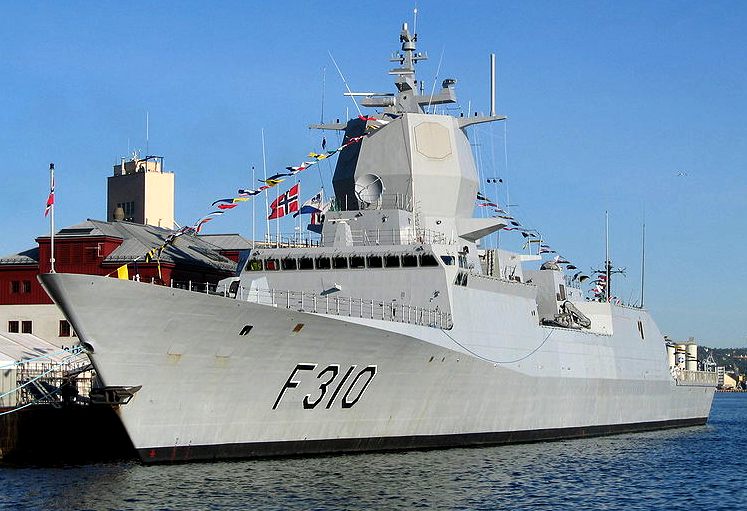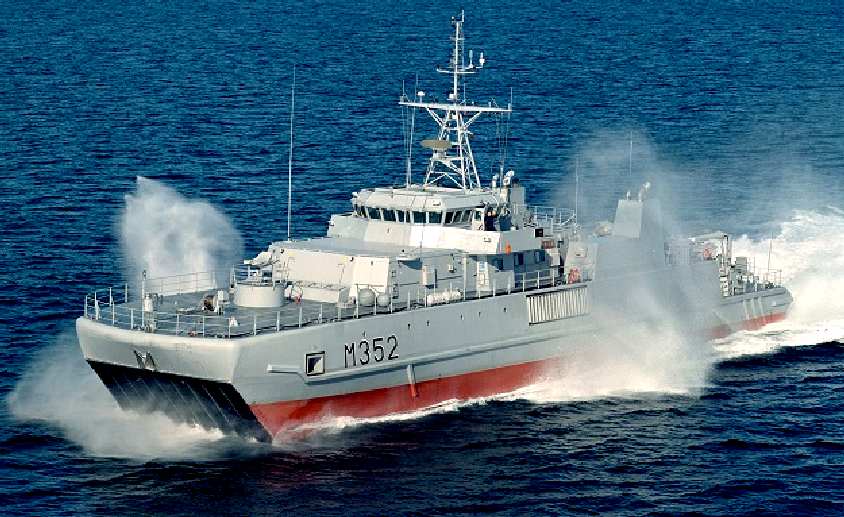|

Norwegian
Navy frigate
RNN
GOES ELECTRIC - MAY 2014
GE’s Power Conversion business
(NYSE: GE) has announced that it is working with Daewoo Shipbuilding and Marine Engineering Co., Ltd. (DSME) in South Korea to provide an electrical power and propulsion system for a
Norwegian Defence Logistics Organization (NDLO) logistics and support vessel (LSV). GE’s equipment will be installed as a key part of the ship’s hybrid propulsion system, improving
fuel efficiency and operating flexibility.
In October 2012, GE’s Power Conversion business announced a similar project for the U.K. Royal Fleet Auxiliary’s new fleet of four military afloat reach and sustainability (MARS) tankers. These will be the U.K.’s next-generation class of large, fast-fleet tankers that will deliver fuel, fresh water and supplies to Royal Navy ships including the
Queen Elizabeth Class aircraft carriers.
Once completed, the NDLO’s newest LSV, built by DSME, will measure 180 meters in length by 26 meters in beam and have a loaded displacement of more than 26,000 tons. The new vessel is planned to enter service in October 2016.
“The future to keeping navies at sea for longer, further from home ports and with increased resilience is by making them as operationally efficient as possible. A key reason we chose GE’s Power Conversion business for our latest logistics and support vessel is because their technologies makes this possible. Coupled with the vast experience GE holds in this domain globally and most recently on the MARS tankers, we feel they are the strongest partner in helping us make sure the latest LSVs are of the highest performance standards,” said Commander Senior Grade (Cdr SG) Christian Irgens of NDLO.
Hybrid propulsion systems—like the one being used for this project—combine both electrical and mechanical equipment to turn the ship’s propellers throughout the speed operating range. The Norwegian LSV will have two independent propeller shafts each driven via a gearbox by either a large propulsion diesel or a relatively small
electric
motor. When the ship is operating at moderate or low speeds, the propeller shafts are turned using GE’s electric motors with speed control for each motor being provided by the use of a low-voltage variable speed drive. The electrical power for the motors is supplied from the generators used to supply the remainder of the ship’s services. This reduces the number of generators in operation and often allows those that are in use to be run at a more efficient operating point.
When the ship is required to operate at higher speeds, the main propulsion diesel engines are started and the propellers are now turned, via the gearboxes, by these engines. The propulsion motors now can be operated in the opposite sense as generators, using a small amount of energy from the propulsion engines to supply electricity to the ship’s services. This in turn allows the ship service generators to be shut down once again reducing overall operating hours of the ship’s
diesels and saving maintenance cost.
This hybrid configuration is a versatile propulsion solution and is particularly suited to the fluctuating operational scenarios encountered by naval warships and auxiliaries. Using electric propulsion motors powered by the ship’s generating sets to turn the propeller saves fuel, reduces emissions and reduces maintenance costs of the main engines, which can be shut down. The generating sets are running to meet other electrical needs of the ship anyway, so the overall number of hours run by the various
diesel engines onboard is reduced.
Not only is GE providing the propulsion motor and variable speed drive equipment to DSME, but it also will supply switchboards, alternators, cargo pump drives and the bow thruster motor and drive. GE Power Conversion system engineers have been working very closely with the DSME shipyard, the NDLO and other equipment suppliers to ensure that the electrical power system is fully integrated and will deliver the efficiency and reliability expected.
“Our electrical drive train technology provides the NDLO with a highly efficient, flexible and integrated power and propulsion system for its critical military operations,” said Mark Dannatt, naval business director for GE’s Power Conversion business. “This project is another example of a growing trend among the world’s navies to use GE’s electric propulsion technology and a good example of how our system design can be tailored to meet the exacting requirements of the owner.”

Alta
class minesweeper RNN
MINE
COUNTERMEASURES - SEPT 2013
Kongsberg Defence Systems
(KONGSBERG) signed a contract for supply of the Minesniper Mk III One Shot Mine Disposal Weapon System to the Royal Norwegian Navy. The contract
resulted from international competition.
The MINESNIPER Mk III System will support the needs of the Armed Forces by introducing new and flexible capabilities for inspection and disarmament of Sea-Mines in the Royal Norwegian Navy. The System consists of a number of
Minesniper Mk III combat vehicles, inspection/training vehicles, logistics and services for integration into the Command and Control System on-board the Navy's six Mine Countermeasure Vessels
(MCMV).
Executive Vice President, Leiv Inge Steig, (Kongsberg Defence Systems) is
quoted as saying: “The MINESNIPER Mk III System will enable MCM operations to be performed in a safer, more rapid and more efficient way. This contract is the result of a long term effort to strengthen our position as supplier of MCM systems, and in this context this is a very important reference contract for
KONGSBERG.”

RNN
HISTORY
The Royal Norwegian Navy (Norwegian: Sjøforsvaret, Den Kongelige Norske Marine or informally "Marinen", often abbreviated as RNoN) is the branch of the Norwegian Armed Forces responsible for naval operations. As of 2008, the RNoN consists of approximately 3,700 personnel (9,450 if mobilized, and 32,000 if fully mobilized) and 70 vessels, including 5 heavy frigates, 6 submarines, 14 patrol boats, 4 minesweepers, 4 minehunters, 1 mine detection vessel, 4 support vessels and 2 training vessels. The navy also includes the Coast Guard.
The Royal Norwegian Navy has a history dating back to 955. From 1509 to 1814, it formed part of the Royal Dano-Norwegian Navy, also referred to as the Common Fleet. Since 1814, the Royal Norwegian Navy has again existed as a separate navy.
In Norwegian, the Royal Norwegian Navy vessels have since 1946 been given the ship prefix "KNM", short for Kongelig Norske Marine (Royal Norwegian Navy). In English, they are given the prefix "HNoMS", short for "His/Her Norwegian Majesty's Ship". Coast Guard vessels are given the prefix "KV" for KystVakt (Coast Guard) in Norwegian and "NoCGV" for Norwegian Coast Guard Vessel in English.
WORLD
WARS
Norway was neutral during World War I, but the armed forces were mobilised to protect Norway's neutrality. The neutrality was sorely tested - the nation's merchant fleet suffered heavy casualties to German U-Boats and commerce raiders.
World War II began for the Royal Norwegian Navy on April 8, 1940, when the German torpedo boat Albatross attacked the guard ship Pol III. In the opening hours of the Battle of Narvik, the old coastal defence ships ("panserskip") HNoMS Eidsvold and HNoMS Norge, both built before 1905 and hopelessly obsolete, attempted to put up a fight against the invading
German warships; both were torpedoed and sunk. The German invasion fleet heading for Oslo was significantly delayed when Oscarsborg Fortress opened fire with two of its three old 28 cm guns, followed by the 15 cm guns on Kopås on the eastern side of the Drøbak strait. The artillery pieces inflicted heavy damage on the German heavy cruiser Blücher, which was subsequently sunk by torpedoes fired from Oscarsborg's land based torpedo battery. Blücher sank with over 1,000 casualties among its crew and the soldiers it carried. The German invasion fleet - believing Blücher had struck a mine - retreated south and called for air strikes on the fortress. This delay allowed King Haakon VII of Norway and the Royal family, as well as the government, to escape captivity.
On June 7, 1940 13 ships, five aircraft and 500 men from the Royal Norwegian Navy followed the King to the
United Kingdom and continued the fight from bases there until the war ended. The number of men was steadily increased as Norwegians living abroad, civilian sailors and men escaping from Norway joined the RNoN. Funds from Nortraship were used to buy new ships, aircraft and equipment.
Ten ships and 1,000 men from the Royal Norwegian Navy participated in the Normandy Invasion in 1944.
During the war the navy operated 118 ships, at the end of the war it had 58 ships and 7,500 men in service. They lost 27 ships, 18 fishing boats (of the Shetland bus) and 933 men in World War
II.
The Royal Norwegian Navy had its own air force from 1912 to 1944.
The building of a new fleet in the 1960s was made possible with substantial economic support from the
United
States. During the cold war, the Royal Norwegian Navy was optimized for sea denial in coastal waters, in order to make an invasion from the sea as difficult and costly as possible. With that mission in mind, the RNoN consisted of a large number of small vessels and up to 15 small diesel-electric submarines. The Royal Norwegian Navy is now replacing those vessels with a smaller number of larger and more capable vessels.
The Royal Norwegian Navy Museum is dedicated to the preservation and promotion of Norway's naval history.
WW3
TECHNOLOGY
TRANSITION
In
the past a great show of strength
meant large ships and submarines cruising the
oceans burning fossil and nuclear fuels at an alarming rate. Today,
most navies see cleaner
technology and persistent monitoring as a better use of resources, even
though they wish to maintain the illusion of strength from large hunks of
floating iron.
In the future solar powered ships could ply the oceans at almost no fuel cost
and may be fully autonomous - thus saving on crews and
lives, should
engagement become necessary.
The
seeds of such technology are being planted in the development of the
Bluefish/SNAV
platform, a small ship
designed to run on energy harvested from nature. Navies may
modify the core design for themselves under licence, or put forward a
specification to meet their needs for development in the UK, or for build by a
contractor in Norway under licence,
which could include the right to build for other navies.
The
future of naval warfare is not having a big ship, but knowing where the
enemy's big ship is - so that it may be neutralized. A big ship is therefore
a pompous liability, other than for propaganda purposes. Whereas,
the real problems of coastal control, charting and mine
countermeasures, are everyday services that need to be done. In our
view, an
effective naval force is one that does its duty as well or better, for less
than other navies.
LINKS
& REFERENCE
http://en.wikipedia.org/wiki/Royal_Norwegian_Navy Sept-2013-Kongsberg-to-supply-minesniper-mk-iii-mine-disposal-weapon-system-to-royal-norwegian-navy http://www.maritimepropulsion.com/news/norwegian-navy-embraces-electrification-569
|



